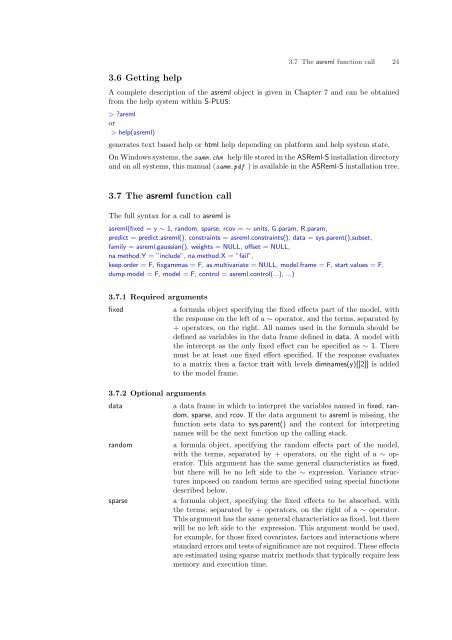ASReml-S reference manual - VSN International
ASReml-S reference manual - VSN International
ASReml-S reference manual - VSN International
- No tags were found...
Create successful ePaper yourself
Turn your PDF publications into a flip-book with our unique Google optimized e-Paper software.
3.6 Getting help3.7 The asreml function call 24A complete description of the asreml object is given in Chapter 7 and can be obtainedfrom the help system within S-PLUS:> ?aremlor> help(asreml)generates text based help or html help depending on platform and help system state.On Windows systems, the samm.chm help file stored in the <strong>ASReml</strong>-S installation directoryand on all systems, this <strong>manual</strong> (samm.pdf ) is available in the <strong>ASReml</strong>-S installation tree.3.7 The asreml function callThe full syntax for a call to asreml isasreml(fixed = y ∼ 1, random, sparse, rcov = ∼ units, G.param, R.param,predict = predict.asreml(), constraints = asreml.constraints(), data = sys.parent(),subset,family = asreml.gaussian(), weights = NULL, offset = NULL,na.method.Y = ”include”, na.method.X = ”fail”,keep.order = F, fixgammas = F, as.multivariate = NULL, model.frame = F, start.values = F,dump.model = F, model = F, control = asreml.control(...), ...)3.7.1 Required argumentsfixed3.7.2 Optional argumentsdatarandomsparsea formula object specifying the fixed effects part of the model, withthe response on the left of a ∼ operator, and the terms, separated by+ operators, on the right. All names used in the formula should bedefined as variables in the data frame defined in data. A model withthe intercept as the only fixed effect can be specified as ∼ 1. Theremust be at least one fixed effect specified. If the response evaluatesto a matrix then a factor trait with levels dimnames(y)[[2]] is addedto the model frame.a data frame in which to interpret the variables named in fixed, random,sparse, and rcov. If the data argument to asreml is missing, thefunction sets data to sys.parent() and the context for interpretingnames will be the next function up the calling stack.a formula object, specifying the random effects part of the model,with the terms, separated by + operators, on the right of a ∼ operator.This argument has the same general characteristics as fixed,but there will be no left side to the ∼ expression. Variance structuresimposed on random terms are specified using special functionsdescribed below.a formula object, specifying the fixed effects to be absorbed, withthe terms, separated by + operators, on the right of a ∼ operator.This argument has the same general characteristics as fixed, but therewill be no left side to the expression. This argument would be used,for example, for those fixed covariates, factors and interactions wherestandard errors and tests of significance are not required. These effectsare estimated using sparse matrix methods that typically require lessmemory and execution time.
















